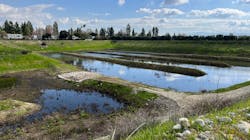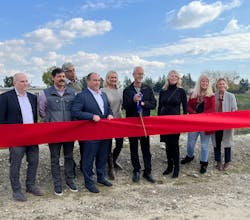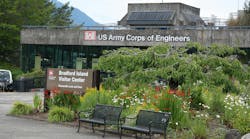Southern California spillway turns stormwater into drinking water
A new project to capture stormwater runoff cascading from nearby mountains and trickling down city streets is helping Chino Basin Water Conservation District (CBWCD) fill its “drought piggy bank.” In wet years, surplus rainwater is channeled into earthen catch basins, where it slowly percolates underground and can be pumped out later for use during dry periods.
The $1.05 million Montclair #2 Spillway Replacement Project helps the district balance the boom-and-bust hydrological cycle common in California by harnessing excess stormwater for basin recharge. The water feeds the massive Chino Groundwater Basin, which provides drinking water for 1.5 million people in inland Southern California.
While the project was years in the making, the timing worked out well for CBWCD and the region it serves. The spillway was completed in October 2022, just in time for the winter’s wave of atmospheric river storms that brought an end to California’s lengthy and profound drought.
“This project is made for winters like this when we are inundated by rain that we can then capture and store underground for dry times,” said Gil Aldaco, CBWCD Board Treasurer, at a January ribbon-cutting ceremony. “Holding the water locally rather than letting it flow out to the ocean, furthers our goal of preserving and protecting the Chino Groundwater Basin.”
The new spillway better connects the first two basins in a four-basin chain adjacent to the San Antonio Creek Channel and allows CBWCD to raise the water level in Montclair Basin #1 by eight feet, which represents 18 million gallons of water. The soil of the Montclair Basins can soak up 18 to 24 inches of water per day, and the sandy, gravelly soil near the creek creates the ideal conditions for percolation and water storage in the aquifer.
The Chino Groundwater Basin is the tenth largest aquifer in Southern California and provides about half of the water supply for the area. CBWCD has spent decades investing in recharge basins to ensure that water can be put back into the aquifer. The area has a network of basins for both recharge and flood control, owned by CBWCD and San Bernardino County Flood Control District.
The organizations work with the Chino Basin Watermaster and the Inland Empire Utilities Agency to maximize the effectiveness and efficiency of all the basins in the area to capture and store as much water as possible, which includes stormwater, recycled water, and imported water from Northern California.
The Montclair #2 Spillway Replacement Project is one element of a comprehensive approach to water resources that addresses limited supply, a growing population, and the complicated effects of climate change.
Stormwater recapture is becoming an integral part of that equation. Historically, stormwater management has focused on safely diverting heavy rainfall to minimize flooding. Like recycled water, stormwater is increasingly viewed as one more resource that can be leveraged to enhance drinking water supplies. Local groundwater is critical for reducing the region’s dependence on more expensive and less reliable imported water.
Since the spillway project provides wide-ranging benefits across multiple communities, CBWCD worked with a coalition of partners – the County of San Bernardino, Inland Empire Utilities Agency (IEUA) and the Metropolitan Water District of Southern California (MWD) – that provided valuable support to help bring the effort to fruition.
The County of San Bernardino provided $300,000 in assistance through the American Rescue Plan Act, which was established to provide economic relief to individuals and communities affected by the COVID-19 pandemic. By allocating a portion of the funds to support local infrastructure projects, the federal government provided immediate relief and long-term benefits to communities served by CBWCD.
CBWCD serves the Inland Southern California cities of Montclair, Upland, Ontario, Chino, Chino Hills, Rancho Cucamonga, and Fontana, which rely on the Chino Groundwater Basin as an essential source of drinking water.
“Our water supply is central to our ability to grow our community and our economy,” said San Bernardino County Supervisor Curt Hagman. “During the drought, we have been reminded that it is crucial to capture every drop we can for our local supplies.”
The spillway complements a planned inlet diversion project by IEUA that will increase stormwater capture by an additional 96 acre-feet per year – enough to serve almost 200 families annually.
“Through this collaboration, we will be able to capture more stormwater annually for use within our region,” said IEUA Board President Marco Tule. “Projects like this are essential to persevering through unprecedented, severe drought like we have seen recently across California.”
MWD, a wholesaler of water from the State Water Project and Colorado River Aqueduct, offered significant support to move the project forward. Since its establishment in 1928, MWD has been dedicated to ensuring that close to 19 million people across six counties enjoy a reliable supply of high-quality water through various infrastructure and water supply initiatives.
To further promote water conservation and sustainability, MWD initiated a Stormwater for Recharge Pilot Program, which offers financial incentives to develop, monitor, and assess up to 10 new or existing stormwater recharge projects. This program provides funding to evaluate such projects' performance and regional water supply benefits. Due to the potential for the Montclair #2 Spillway Replacement Project to positively impact aquifer levels in areas benefiting from CBWCD, MWD provided a $1 million grant. The funding was instrumental in ensuring the project's timely completion.
“We are excited about this project because it improves infrastructure that already exists, which allows us to do more with our resources,” MWD Groundwater and Stormwater Manager Matt Hacker said.
Collaboration is key
The collaboration of multiple agencies demonstrates how efforts such as the Montclair #2 Spillway Replacement Project not only advances the goals of each organization but also provides direct benefits to hundreds of thousands of residents in multiple communities.
“IEUA takes pride in our relationship with regional agencies, and we are proud to partner with the Chino Basin Water Conservation District and the Metropolitan Water District of Southern California to advance our agencies’ goals of protecting and preserving the quality of life for residents throughout the basin,” Tule said.
Addressing the water climate crisis requires a comprehensive and coordinated approach from government, industry, and society; CBWCD has set an excellent example for California agencies in bringing all three together. In addition to creating valuable partnerships and projects, the district also provides free water conservation education to its service area.
The success of the spillway project demonstrates the value of investing in critical infrastructure and stormwater recharge to support communities' long-term growth and sustainability.
Elizabeth Skrzat serves as General Manager for Chino Basin Water Conservation District in Montclair, California. The Chino Basin Water Conservation District was formed in 1949 to help protect and preserve the Chino Groundwater Basin for the San Bernardino County communities that rely on it as a water source. Its formal service area includes all or part of the cities of Chino, Chino Hills, Montclair, Ontario, Fontana, Rancho Cucamonga, and Upland.




